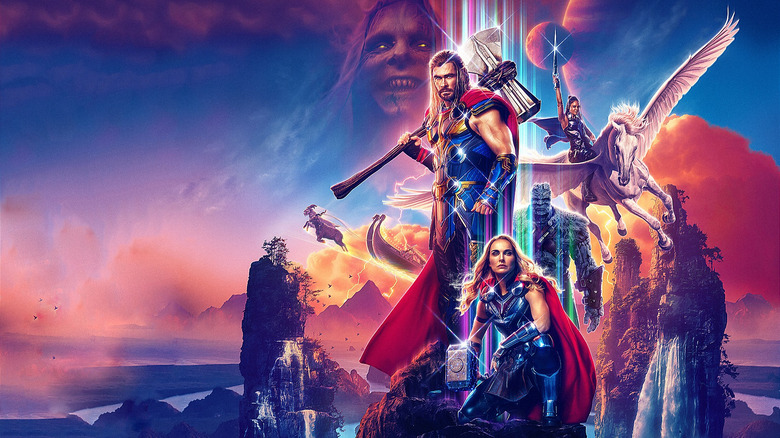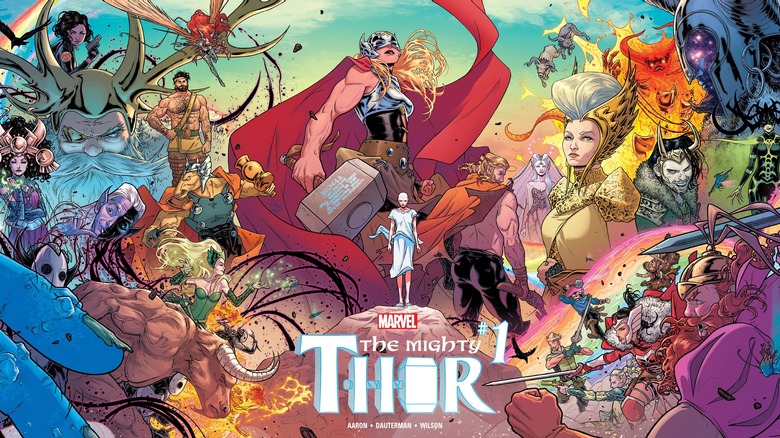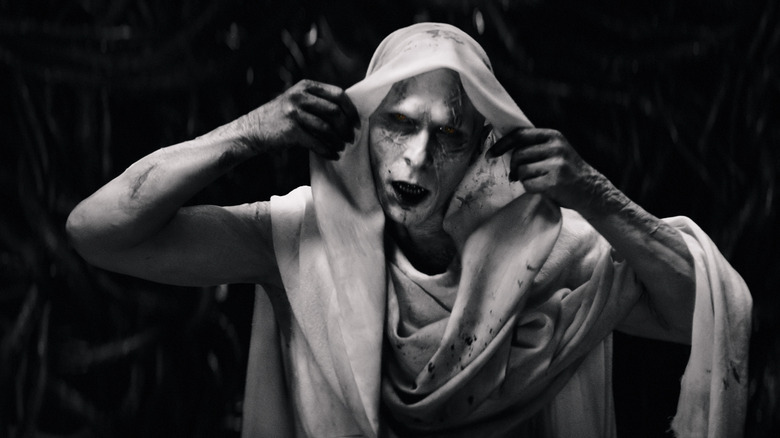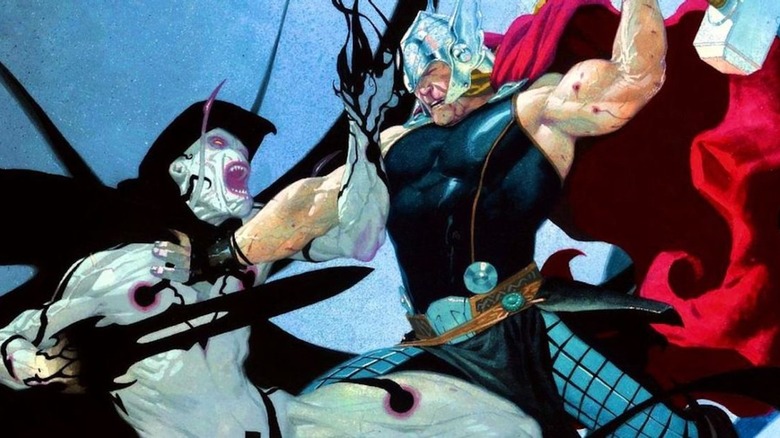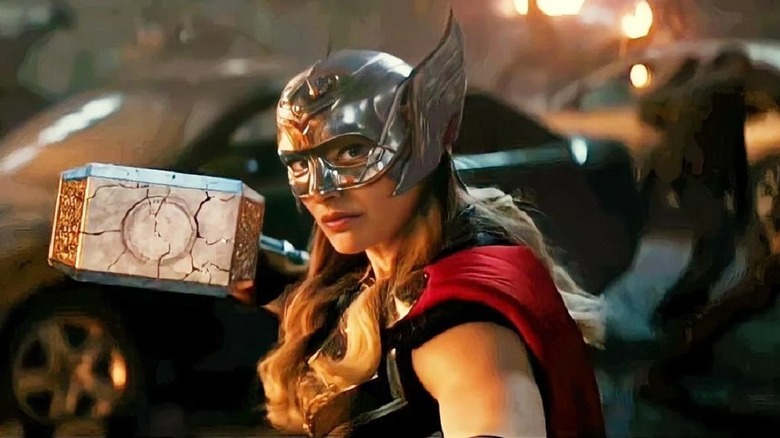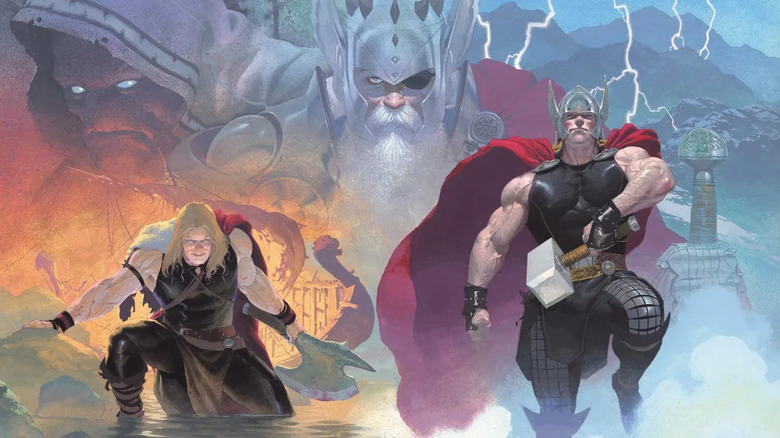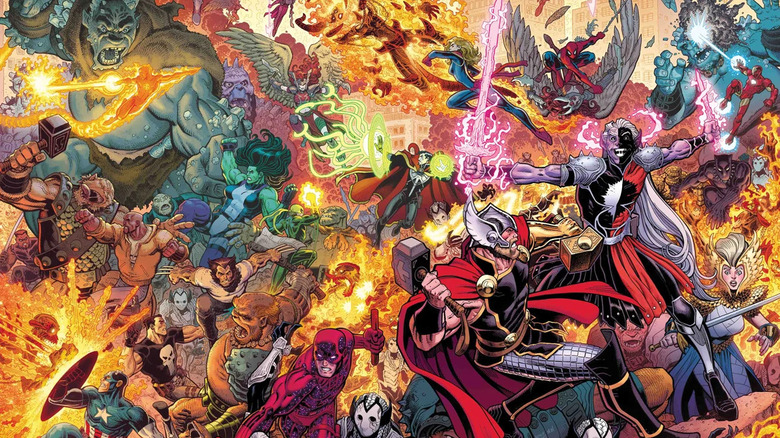Every Major Change Thor: Love And Thunder Makes From The Comic Run That Inspired It
How do you adapt characters with decades upon decades of source material? As far as the Marvel Cinematic Universe is concerned, you pick two to three specific stories and meld (or muddle) them into one. Taika Watiti's "Thor: Love and Thunder" is no different, mashing together comic arcs from "The God Butcher," where Thor faces off against the villain Gorr, who has a grudge against deities, and "Thor: Goddess of Thunder," where Jane Foster becomes the new wielder of Mjolnir.
Both arcs are the work of the same writer, Jason Aaron. What changes did Watiti and co-writer Jennifer Kaytin Robinson make to his source material to bring it to the silver screen? Let's find out.
Jason Aaron's Thor
Jason Aaron wrote Thor between 2012 and 2020. The title relaunched many times during Aaron's oversight — it began as "Thor: God of Thunder" from 2012 to 2014, rebranded as just "Thor" for 2014-2015, became "The Mighty Thor" in 2015-2018, went back to "Thor" in 2018-2019, then mini-series "King Thor" closed the epic out with an epilogue in 2020. Counting related spinoff material (such as mini-series "Thors" and "The Unworthy Thor" or crossover event "War of the Realms"), the run is about 100 issues.
The title branding is complicated, especially if you don't usually follow superhero comics, but the narrative is actually pretty straightforward. Over the run, Aaron worked with a variety of artists, chief among them Esad Ribic (for "The God Butcher") and Russell Dauterman (for most of the issues where Jane is Thor). Ribic's art is painterly watercolors with gorgeous backgrounds, while Dauterman's is brightly shaded and character-centered.
The central theme of Aaron's run is a question: Does the universe need gods? That's why the kickoff villain is a mortal who kills gods and for much of the run, a mortal woman is Thor, not Odinson. There's also a strong political streak in the run: The arc "Lords of Midgard" shows how in a capitalist society, wealth is a god, with billionaires its high priests. "Love and Thunder" offers some shallow exploration about the necessity of gods, but it doesn't ask any of the hot-button questions that many of the titles during Aaron's run does.
Changes to Gorr
The Gorr of "Love and Thunder" has some stark differences from the comics. In both comics and the movie, Gorr is a former mortal who lived on a dying world and lost faith due to his gods' silence and the death of his family (in the comics a wife and son, in the movie a daughter). Acquiring the Necrosword, he swore to slay all gods — and that's where the similarities really end.
First off, there's the design. Gorr is less humanoid in the comics, with a noseless face, a hairless body, chalk-white skin, and head tentacles. In "Love and Thunder," Gorr boasts gray, scarred skin with yellow velociraptor eyes, and he wears a white tunic. What both designs have is a full row of pointed teeth and a wicked grin. In an interview with IGN, Taika Watiti said accurately that re-creating comic Gorr would look too much like Voldemort, and to be sure, the final design does wonders for Christian Bale's expressiveness.
There's also his weapon. The Necrosword is a god-killing weapon forged by Knull, creator of the symbiotes. Befitting its origin, the sword mostly appears as black tendrils engulfing its host, who can bring forth constructs from it. In "Love and Thunder" its origins are more nebulous, and it appears as a more conventional metal blade. However, it still has the ability to conjure monsters from shadows.
Jason Aaron himself approved of the changes. In a recent edition of his newsletter, titled "The Origin of Gorr the God Butcher," he wrote:
"Yeah, he looks different. But since when does 'different' automatically equate to 'wrong'? Things always have to evolve as part of an adaptation, for all sorts of different reasons. And for my money, the core parts of the character remain on the big screen."
Gorr cont.
Gorr's goal is to kill all gods in one fell swoop, but his methods for reaching his goal differ between "The God Butcher" and "Love and Thunder." In the comics, Gorr enslaves gods to build a massive explosive called "the Godbomb." In the movie, he steals Thor's ax, Stormbreaker, to access the Bifrost bridge and teleport to Eternity, the center of the universe. There, he can wish for the destruction of the gods.
How his quest ends is another point of divergence. Comics Gorr creates constructs of his lost family; he kills the facsimile of his wife when she observes that, as a powerful immortal, Gorr has essentially become a god himself. His "son," Agar, then works with Thor to defeat Gorr. "Love and Thunder" Gorr, on the other hand, decides to use his wish to bring his daughter back to life instead and dies peacefully.
Finally, Gorr actually isn't in the Aaron run all that much. At the end of the run's opening storyline, he's vanquished and only returns for the epilogue of "King Thor." Gorr's actions still cast a shadow over the run; Thor's unworthiness is because he starts to feel that Gorr was right about the universe not needing gods. However, the God Butcher plays no part during Jane Foster's tenure as the Thunderer.
Changes to Jane
Speaking of Jane Foster, the essentials of her story are there in "Love and Thunder": She's dying of cancer but finds herself worthy of wielding Mjolnir. Tragically, her new power is actually killing her faster.
A couple of details about this situation are different. In the movie, the reason Jane can wield Mjolnir is Thor instructed the hammer to watch over her. In the comics, it's because Thor himself had become unworthy and the hammer needed a new wielder to fill the void. The comics also say the problem is whenever Mjolnir transforms Jane, it purges her body of toxins and illness. Unfortunately, this includes chemotherapy drugs, whereas the tumor registers as a natural part of her. The movie goes with a simpler explanation, that wielding divine power saps her already limited strength.
Now some more big picture changes. In the comics, the Goddess of Thunder's identity was initially a mystery; it was only confirmed to be Jane in "Thor" (2015) #8. In the movie, there's no such mystery. Compare this to "Captain America: The Winter Soldier," which at least kept a pretense of the original arc's mystery. "Love and Thunder" is more up front. Then there's the ending. In the comics, Jane has one last battle with the monstrous Mangog and is at death's door, but Thor pulls her back to life. From there, she retires from superhero-ing and beats cancer. In the movie, she dies a god's death and finds herself in Valhalla.
Changes to Thor
Now, the man of the hour. During "Love and Thunder," Thor Odinson and Jane Foster Thor exist simultaneously; in the comics, this wasn't the case. After being unworthy of wielding Mjolnir and being convinced that Goddess of Thunder was a worthy successor, Thor cast off his name to become just "Odinson," took up the ax Jarnbjorn and went into exile. For most of Jason Aaron's run, he's absent, and Jane is fully serving in his stead. Mini-series "The Unworthy Thor" covers what he did in the meantime. MCU Thor, though, never lost his worthiness. There's even a comedy beat where he lifts Mjolnir — just to be sure he still can. While he still wields an ax while Jane takes the hammer, Stormbreaker can still control lightning and is functionally quite similar to Mjolnir.
Aaron's run also includes multiple timelines, following Thor at different points in his life. "God Butcher" chronicles Thor's first encounter with Gorr in the Viking age, the villain's reemergence in the 21st century, and a distant future where an aged Thor is king of Asgard with three granddaughters: Atli, Ellisiv, and Frigg. This becomes less prominent as the run goes on, but the story occasionally returns to the aged Thor, chronicling how he rebirths life on Earth. "Generations: The Unworthy Thor & The Mighty Thor" #1 also sees Jane travel back in time and meet the young Thor; they fight alongside each other against Apocalypse in ancient Egypt.
"Love and Thunder," barring brief flashbacks to previous movies, sticks with Thor in the current moment.
Absent characters and arcs
Aside from Gorr, Jason Aaron's run introduced a second villain: Dario Agger, an oil CEO who turns into the Minotaur. Agger is the series' walking critique of disaster capitalism and a longer-lasting villain than Gorr; he reappeared as a major villain in Al Ewing and Joe Bennett's excellent series, "Immortal Hulk." Before Bale's "Love and Thunder" character was confirmed, some (Aaron included) had even speculated he would be playing Agger, not Gorr.
However, the main villain of Aaron's "Thor" is neither Gorr nor Agger — it's actually Malekith the Accursed. After manipulating his way to the throne of his home realm Svartalfheim early in "Thor: God of Thunder," Malekith forges alliances across the Nine Realms with the goal of conquering them all. His machinations build throughout the run and climax with crossover event "War of the Realms," the grand finale of Aaron's "Thor." "Love and Thunder" adapts nothing concerning War of the Realms. A big reason is Malekith was previously featured in "Thor: The Dark World" and has the dubious honor of being the go-to example for lame Marvel villains.
Since Aaron's "Thor" had a lot more time to tell its story than the mere two hours "Love and Thunder" did, it had a lot more supporting characters: Loki, Odin, Frigga, SHIELD agent/environmentalist Roz Solomon, Laufey, Hela, Thanos, the Destroyer, the alien Shi'ar, and many more. None are in "Love and Thunder," especially since many are dead in the MCU. At the same time, Valkyrie also has a much smaller role in the comics and dies in "War of the Realms." Tessa Thompson's Brunnhilde, on the other hand, is the film's third most important character after Thor and Jane.
"Thor: Love and Thunder" is in theaters now.
